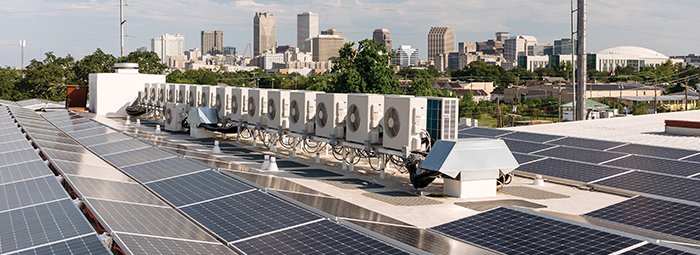
©2021 This excerpt taken from the article of the same name which appeared in ASHRAE Journal, vol. 63, no. 9, September 2021.
About the Authors
Peter Rumsey, P.E., is the founder and CEO of Point Energy Innovations in San Francisco and cofounder of the Stanford Building Decarbonization Learning Accelerator in Stanford, Calif. Jorlyn Le Garrec is a project engineer, and Avril Levasseur, P.E., is an associate engineer at Point Energy Innovations in San Francisco.
By the end of 2050, 12 states and 160 cities have official goals to get 100% of their electricity from clean sources. California cities are leading the nation in building electrification legislation, with 28 cities having adopted all-electric requirements for new construction; 50 additional cities and counties have pending electrification legislation as of this writing. Much of the southeast U.S., where heating loads are light, already uses electric sources of heating. And, in moderate and cold climates a surge of interest exists in heat pump systems, which provide an efficient alternative to electric resistance for heating. This article explores heat pump systems as one way building decarbonization can transform HVAC.
Buildings in the U.S. account for 40% of carbon emissions. Eighty percent of that is from electricity use and the remainder is from the combustion of fossil fuels for heating and other uses at the building. Many states, utilities, and large corporations are moving to get electricity from clean, carbon neutral sources. Duke Energy, one of the largest investor owned utilities in the U.S., has committed to having 100% of its energy from carbon-neutral sources by 2050. In addition, many of the U.S.’s largest corporations including Apple, Microsoft, Kohl’s, Walmart and Bank of America have made commitments to achieve carbon neutrality or to get their electricity from carbon free sources, namely solar and wind energy.
It is clear that electricity is becoming the carbon free choice of energy for many in the U.S. Buildings that use natural gas and other fossil fuels for heating will be stuck producing carbon emissions, as electricity becomes increasingly carbon free. For that reason, many are starting to look at all-electric options for providing heat to buildings. An all electric building coupled with a renewable or carbon-free source of electricity is considered to be decarbonized in its operation.
In addition to operational carbon, buildings have embodied carbon. Embodied carbon is the total greenhouse gas emissions from the materials and the construction process throughout the life cycle of the building. While both embodied and operational carbon emissions must be reduced in a decarbonization effort, embodied carbon is a one-time carbon emission during the construction process. Operational carbon, on the other hand, is continuously emitted and significantly outweighs the embodied carbon over a 50-year lifetime of a building. This article will only be addressing operational carbon, which is where the responsibility of those in ASHRAE lies.
Building HVAC systems, water heating and even cooking will be transformed by the move to decarbonized buildings.
Grid Carbon Intensity
The ease of implementing building decarbonization is greatly dependent on the local electricity grid. A building owner is able to make the decision to eliminate on-site fossil fuel use and add photovoltaic (PV) panels to their building, but has no control over the source of energy at the utility level. Three potential scenarios exist for decarbonizing depending on the grid.
Read the Full Article
ASHRAE Members have free access to the full-text PDF of this article as well as the complete ASHRAE Journal archives back to 1997 in the Free Member Access Area.
Non-members can purchase features from the ASHRAE Bookstore. Or, Join ASHRAE!
Return to Featured Article Excerpts
Return to ASHRAE Journal Featured Article Excerpts